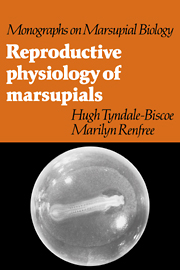Book contents
- Frontmatter
- Contents
- Preface
- 1 Historical introduction
- 2 Breeding biology of marsupials by family
- 3 Sexual differentiation and development
- 4 Male anatomy and spermatogenesis
- 5 The female urogenital tract and oogenesis
- 6 Ovarian function and control
- 7 Pregnancy and parturition
- 8 Lactation
- 9 Neuroendocrine control of seasonal breeding
- 10 Marsupials and the evolution of mammalian reproduction
- References
- Index
Preface
Published online by Cambridge University Press: 06 January 2010
- Frontmatter
- Contents
- Preface
- 1 Historical introduction
- 2 Breeding biology of marsupials by family
- 3 Sexual differentiation and development
- 4 Male anatomy and spermatogenesis
- 5 The female urogenital tract and oogenesis
- 6 Ovarian function and control
- 7 Pregnancy and parturition
- 8 Lactation
- 9 Neuroendocrine control of seasonal breeding
- 10 Marsupials and the evolution of mammalian reproduction
- References
- Index
Summary
The three sub-classes of living mammals are distinguished most clearly by their modes of reproduction, which have developed independently during the past 100 million years of their separate evolution. Study of the differences in reproduction between monotremes, marsupials and eutherians helps to throw light on the origins of mammalian reproduction, especially the origin of mammalian viviparity. More importantly, comparisons between these three groups elucidates general principles by disclosing the different means that each has used to achieve the same ends. The central control of ovarian function, the nature and the role of the corpus luteum, the transport and fate of the germ cells at fertilisation, maternal recognition of pregnancy, the initiation and control of lactation, and the neuroendocrine control of seasonal reproduction are all topics that interest the student of reproduction and to which the results of studies on marsupials are contributing new insights.
This is the first attempt to bring the wealth of material, old and new, on marsupial reproduction within one book. In attempting to do this we have been greatly helped by our many colleagues who have generously read those parts that cover their speciality and given us the benefit of their criticism. While we accept responsibility for what is written we thank Des Cooper, Brian Green, Mervyn Griffiths, Lyn Hinds, Jim Kenagy, Russell Jones, Steve McConnell, Kevin Nicholas, Jeremy O'Shea, John Rodger, Lynne Selwood, Brian Setchell, Geoff Sharman, Geoff Shaw and Peter Temple-Smith for reading particular chapters, and we especially thank John Calaby and Roger Short for giving us the benefit of their wide experience on all aspects of the book.
- Type
- Chapter
- Information
- Reproductive Physiology of Marsupials , pp. xiii - xivPublisher: Cambridge University PressPrint publication year: 1987



